Objev rytin v Inca Wasi - Peru
06-Incawasi-sidlo bohů.pdfObjev rytin na skalních blocích v Incawasi v Peru poblíž Huaytary
El descubrimiento de grabados en bloques rocosos en Incawasi en Peru cerca de Huaytara
Otto Horský
Říše Inků na vrcholu své vlády zabírala v délce 5 500 km větší část andského hřebenu. Před příchodem španělských dobyvatelů v roce 1532 byla pravděpodobně největší známou civilizací, ovládající území od Quita v Ecuadoru až po řeku Rio Maule v Chile.
Inkové tvořili jen úzkou vrstvu vládnoucí třídy, soustřeďující moc vojenskou, úřední i náboženskou. Jejich nadvládu upevňoval imperiální náboženský mýtus o prvotnosti této kultury – hlásali, že před nimi žádná civilizace neexistovala. Stejně tomu bylo i v jiných vyspělých kulturách. Ta nová, dominantní, usilovala skoro vždy o likvidaci všeho, co ji předcházelo. Teprve archeologické nálezy, zejména v minulém století a cílevědomé studie pravěké keramiky na územích dřívější incké říše Tahuntinsuyu, neboli „Země čtyř částí“ upozornily na obrovskou šíři a časovou hloubku mnoha andských civilizací, které tu inckou předcházely. Bohužel, Španělé se k ruinám a pohřebištím po celá staletí chovali jako k důlnímu pozemku a u části obyvatelstva, zejména indiánského, je tomu tak doposud. Vedlejším produktem při rabování archeologických lokali a pohřebišť byla keramika, která však většinou nacházela své místo v uměleckých sbírkách evropských muzeí či soukromníků. Stranou odborného zájmu zůstávalo studium rytin a kreseb vytvořených předchozími civilizacemi v andské oblasti na skalních blocích, sloužících jako obří plátna pro znázornění výjevů zvířat a lidských bytostí, nebo mýtických výjevů. Snad právě proto, že pro jejich velké rozměry je nebylo možno přemístit do muzeí či soukromých sbírek. Ekonomicky se tedy jednalo a stále jedná o málo zajímavé objekty. Snad druhým důvodem, proč se o nich dosud málo ví je lidská nevšímavost a ignorance. Nebo také neschopnost vidět něco, co vyžaduje určitou míru představivosti a intuice.
Inkové během své vlády a imperiální politiky vytvořili říši, srovnatelnou s římským či otomanským impériem. Na rozdíl od nich se však vždy nejdříve snažili domluvit se mírovou cestou s kmeny, které hodlali začlenit do říše. K takto začleněným kmenům se pak chovali jako ke spojencům, ne jako k nepřátelům. Ne vždy se jim to však podařilo a bylo třeba se připravit na dlouho trvající krvavou válku. Nebylo jednoduché ve vysokých horách, které obývali, soustředit rychle potřebnou armádu a připravit ji k bitvám. Proto budovali přechodná vojenská stanoviště, předsunuté vojenské tábory, sloužící k ubytování Inky, generálů a dalších vojenských hodnostářů, úředníků, služebnictva a vojáků určených k vedení války. Tyto nazývali buď Incahuasi, nebo Incawasi, což znamená „dům Inky“. Protože tyto imperiální války byly vedeny hlavně po nástupu Inky Pachacutiho na trůn (1438–1471) a později v období vlády jeho nástupce Tupaca Yupankiho (1471–1493), předpokládá se, že tyto vojenské tábory byly vybudovány v době jejich vlády.
Incahuasi má obvykle tři sektory: incký, náboženský a Inkův palác. Incká čtvrť měla domy s byty, nádvořími a ulicemi. Inkův palác měl lichoběžníkový tvar a byl umístěn na nejvyšším místě. Mezi inckým palácem a inckou čtvrtí pak byla umístěna čtvrť duchovní a sklady potravin, výzbroje a jiných potřebných věcí.
V rámci programu české výzkumné expedice Titicaca 2004 jsme navštívili celou řadu ruin inckého a předinckého osídlení za účelem srovnávacích studií nejen v oblasti jezera Titicaca, ale i v jiných oblastech Peru. Mezi navštívené lokality patřily i ruiny Incawasi.
Po návštěvě města Pisco, které je vyhlášeno svým oblíbeným destilátem z hroznů se stejným názvem, jsme se vydali po silnici „Los Libartadores“, která vede do Ayacucha a asi po 112 km jsme dorazili do nádherného města s názvem Huayatara. Toto město se vyznačuje nejen nádhernou a nezapomenutelnou přírodní scenérií, ale i velmi důležitými inckými ruinami, které snesou srovnání s těmi v Cuzku či na Machu Picchu. Celkem zde bylo dosud zdokumentováno přes 1200 archeologicky významných nálezů na 98 různých lokalitách.
Město s 25 000 obyvateli se nachází v pohoří Západní Kordillery v nadmořské výšce kolem 2500 metrů. Přes tuto značnou nadmořskou výšku se vyznačuje velmi příhodnými klimatickými podmínkami. Cestovní příručky uvádějí, že se jedná o město věčného jara. Průměrná roční teplota dosahuje 17 Co. Právě díky tomuto příznivému klimatu se v oblasti rozvinulo intensivní zemědělství a chov dobytka. Kromě přírodních krás však nabízí Huaytara a její blízké okolí architektonické skvosty a ruiny, které stojí za to navštívit, i když jsou poněkud stranou obvyklých turistických cest. Mezi nejvýznamnější incké památky patří bezesporu „El Templo Inca“-Inkův palác, „Los Baňos del Inca“-Inkovy lázně s teplou a studenou vodou, obojí přímo v Huaytaře, dále pak terasy ve svazích „Sumaq-Pata“ a zejména ruiny vojenského tábora Incahuasi.
Z Huaytary jsme pokračovali po silnici Los Libertadores směrem na Ayacucho. Asi po 20 km, za malou umělou lagunou, jsme se vydali do leva po neudržované polní cestě a asi po dvou kilometrech jízdy jsme museli automobil zaparkovat na poslední výspě, přístupné ještě terénnímu vozidlu. Níže pod námi se rozkládaly obrovské kamenné bloky rozseté po stráni a pod nimi v plytkém údolí komplex inckých ruin, Incawasi.
Při pohledu shora na ruiny pod námi se člověku tají dech. Místo jako stvořené pro Bohy. Dále již musíme jít pěšky. Na výspu ve výši 3900m, sloužící zároveň jako vyhlídka na ruiny, jsme se dostali automobilem a bez předchozí aklima-tizace. A tak i cesta dolů na ruiny po pěší stezce do výše „pouhých“ 3775 m není procházka rajskou zahradou. Nalézáme majestátní siluety incké architektury, zchátralé zdi z perfektně opracovaných bloků kamene zasazených do sebe bez malty s obdivuhodnou přesností, s okny, dveřmi, průčelími a schodišti, které si s ničím nezadají s podobnými stavbami v Cuzcu či na Machu Picchu. Ulice a náměstí s Intihuatanou (slunečními hodinami), ve velkém bloku vytesaná malá a velká sedačka pro Inku a některou s jeho konkubín, skladiště potravin pro civilní obyvatelstvo a vojsko, areál s příbytky a obřadními místy pro Boha Slunce a Matku Země. A všudypřítomná voda, zurčící uměle vytesanými kanálky. Podle archeologů, zub času a lidská lhostejnost způsobily, že dnes se zachovalo s celého architektonického skvostu jen asi 20% původní zástavby. Ale i ty stojí zato.
Při zpáteční cestě nahoru, kde stál zaparkován náš terénní automobil, jsem se musel několikrát zastavit, abych si odpočinul. Nedostatek kyslíku a žár poledního slunce vykonaly své. Když jsem se dostal zpět na výspu a s obdivem pohlédl zpět na komplex ruin Incahuasi, můj pohled spočinul znovu na obrovských skalních blocích přímo pod námi. Tyto a celá řada dalších bloků vpravo vytvářely přirozenou bránu a hradbu před sestupem do bývalého vojenského tábora. Stál jsem jako omráčen. Na levém bloku jsem spatřil jasně se rýsující majestátní postavu boha nebo kazatele. Ve zvednutých rukou třímal žezlo a díval se k nebi. Na pravém bloku byla jasně zřetelná postava sedícího bojovníka s přilbou na hlavě, vpravo od něj stál hranatý a neforemný bojovník jako jeho tělesná stráž. Zprava byl ohrožován nějakou podivnou nadpřirozenou bytostí. Jen mimoděk sklouzl můj pohled i na protilehlý svah vpravo, po němž jakoby se pohybovali, díky hře světla a stínů v tetelícím se slunci, obří brouci z kamene.
Pracovní program expedice byl velmi náročný a nebyl zaměřen na studium skalních rytin. Všichni ostatní již dávno odešli, aby nezatěžovali automobil při náročné cestě zpět po polní cestě, včetně přejezdu vyschlého štěrkového řečiště. Nebylo možné vrátit se dolů ke skalním blokům s mýtickými výjevy a podrobně je zdokumentovat. Pořízené fotografie a videozáznam však jasně ukazují obrazce a je jich pohromadě tolik, že se jedná o objev ojedinělý. Teprve jejich další studium doma umožnilo rozpoznání celé řady dalších detailů, které vzhledem ke krátkosti času nebylo možno postřehnout. Tělesná stráž připomíná robota, neboť postava je hranatá a neforemná a ruce má ve tvaru mechanických kleští. Vpravo nad jeho hlavou je jasná postava malého človíčka s velkou hlavou v sedící poloze, nějakého humanoida, kteří byli popsáni i z jiných oblastí Peru. Má velmi výrazné oči a uši. Podobné bytosti pravděpodobně obývaly i těsné a nízké příbytky v ruinách „Velké tvrze“ na plochém vrcholu Marcahuasi (Roman Warszewski, 2000). Na levém bloku vpravo od postavy kazatele je znázorněna ovce, dole pod ní je vznášející se postava motýlího muže s upaženýma rukama ve tvaru křídel. Na třetím bloku, který přímo v terénu nebyl objektem mého zájmu, je vytesána hlava pumy, která byla Inky uctívána. Vyryté obrazce jsou tak dokonalé, že svědčí o mimořádném talentu tvůrců. Jde o mytologické postavy, nebo jsou odrazem reality? Jsou výtvorem lidských bytostí, nebo jde pouze o náhodu a jsou dílem přírody? Jako geolog bych se měl snažit o vysvětlení přírodního původu rytin. Velké teplotní rozdíly mezi dnem a nocí, skalní bloky bičované větry a deštěm v době nepohody, to vše jsou faktory, způsobující intenzivní erozi skalních bloků. Ale že by příroda postupovala podle tak přesného scénáře, který by byl dokonalým odrazem reality? To se nezdá pravděpodobné. Připusťme tedy, že na těchto skalních blocích zapracovala lidská ruka, éterické nadšení a víra v nadpřirozeno, provázející celý život jejich tvůrců. A stáří těchto výjevů? Nepředpokládám, že by byly z období před inckých kultur, neboť uvedené klimatické podmínky by nedovolily jejich zachování po celá tisíciletí.
Inkové s oblibou využívali skály a skalní bloky k uměleckému ztvárnění do tvaru božstev, lidských bytostí či uctívaných zvířat. S podobnými výjevy se můžeme setkat v již uvedeném Marcahuasi, nebo poblíž jihoperuánského města Arequipa. Při mé návštěvě ruin Kenka v blízkosti města Cuzca se mi podařilo zdokumentovat monolit, o němž se dosud vedou spory, zda znázorňuje sexuální symbol, tuleně, nebo pumu. Jak ukazuje moje fotografie a obrázek malíře Karla Janáka, jde bezesporu o pumu.
Skalní bloky v Incahuasí na stráních před vstupem do vojenského tábora se přímo nabízely, aby byly využity jako obří plátna pro znázornění božstev a dalších bytostí a výjevů. Konečně, velká Inkova armáda většinou tábořila na daném místě i několik měsíců, takže bylo dost času nejen na výstavbu tábora, ale i na umění. Další podrobné studium objevených skalních rytin a pohledy na bloky kamene z různých stran mohou přinést ještě nejedno překvapení.
Indiáni podobné rytiny ve skalních blocích znají i z jiných míst Peru. Vyprávěli mi o tom. Tvrdí, že se jedná o bytosti zakleté do kamene. V případě Incahuasi je podivné, že se na levém bloku objevuje spíše křesťanský motiv, výjevy na pravém bloku připomínají mimozemské bytosti. Jsem však dalek od toho přiznávat obrazcům mimozemský původ, stejně jako nevěřím, že by byly jen hříčkou přírody. Objevené rytiny, běžně ztvárňované Inky i na jiných místech, vytvořené s naprostou dokonalostí, s očima, ušima, rukama, to přece je více než výmluvné.
Před odjezdem naší expedice mě můj přítel, pocházející z peruánského Altiplana upozornil, že se v Peru ve vysokých horách setkám s tajemnem v jeho nejarchaičtější podobě. S mnoha jevy či úkazy, jimž nebudu okamžitě rozumět a které se mě budou jevit téměř nepochopitelnými. Vybavila se mi vzpomínka na moji první návštěvu královského města Inků Cuzca v roce 1975, kdy mi starosta se zaujetím vykládal o tajemných pozorováních akrobatických rejdů světel na noční obloze a o pozorováních neidentifikovatelných létajících předmětů. Objev skalních rytin v Incahuasi však předčil všechna moje očekávání. Místo je bohužel zatím natolik nepřístupné a stranou běžných turistických cest, že pokud je hodlá někdo navštívit, bude tak asi muset učinit ve vlastní režii. Z hlediska studia prehispánské historie je nutno považovat ruiny Incahuasí za významný archeologický celek a vlastní rytiny za přínos k poznání života a cítění Inků.
El descubrimiento de grabados en bloques rocosos en Incawasi en Peru cerca de Huaytara
Palabras del Alberto Salas Barahona
El descubrimiento de grabados en bloques rocosos en Incahuasi en Peru se describe en detalle en el libro „Incawasi – la sede de los Dioses“ (Incawasi – sidlo bohů). © 2010,Repronis. Es uno de los resultados de los estudios realizados durante la expedicion Titicaca. Su concepcion data de un tiempo anterior a la expedicion, por cuanto tuvo la dedicacion de preparar tecnica y cientificamente dicho viaje, efectuando previamente los estudios comparativos de distintas ruinas incaicas, especialmente en la zona de Huaytara, Cusco, Machu Picchu, Ollantaytambo, Pisac, Sacsayhuaman, Puca Pucara, Kenko, Tambo Machay, entre otras. La validez de hipotesis de trabajo de Otto Horsky fue demostrada con las comprobaciones hechas en el terreno. Los capitulos basicos del libro estan referidos a la notable arquitectura incaica y los materiales utilizados para las construcciones monumentales mencionadas, tales como el templo de Kenko, almacenes, recintos administrativos y defensivos, como son por ejemplo Sacsayhuaman, Incawasi y Tambo Colorado, entre otras ruinas. La presentacion viene acompanada no solo de fotografias del autor, sino tambien de las pinturas del artista checo Karel Janak. El Ing. Horsky pone de relieve que los restos arqueologicos en el Incawasi, cerca de la ciudad de Huaytara, son similares a los de Machu Picchu, por la utilizacion de piedras perfectamente talladas a medida. En dicho lugar, a la entrada de las ruinas precisamente, Otto Horsky descubrio grandes piedras de tamano ciclopeo con pinturas rupestres probablemente de significado religioso. Aunque en el Peru hay registrados algunos centenares de sitios con pinturas rupestres, especialmente en el Altiplano y en los valles interandinos, cada descubrimiento significa un aporte al mejor conocimiento de las culturas precolombinas. Las rocas y piedras grabadas que existen de esa epoca tienen como principal caracteristica que se encuentran en espacios abiertos, integradas al paisaje accesible a cualquier visitante. Por ello, con buen criterio, el autor del libro resalta la necesidad de adoptar medidas adecuadas para preservarlas del dano que pudiera causar el turismo no controlado.
Este libro manifiesta, con el pleno convencimiento, de que incrementara de manera muy significativa el conocimiento sobre los vestigios y las ruinas de ancestrales e importantes culturas que poblaron el Peru actual. Por su contenido, este libro se suma a otros importantes estudios de investigadores, exploradores y cientificos checos que, desde el Siglo XVII realizaron las expediciones y viajes al Peru, difundiendo los resultados de sus viajes a traves de testimonios escritos.
Alberto Salas Barahona, Embajador del Peru en la República Checa, 25 de febrero de 2010..
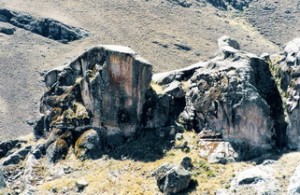
Skalní bloky s rytinami ve svahu nad Inca Wasi. Foto Otto Horský, 2004..
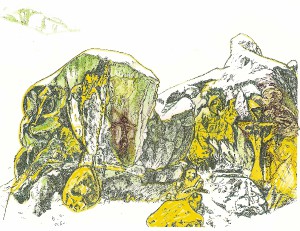
Kresba skalních rytin od malíře Karla Janáka dle fotografie Otto Horského, 2010.
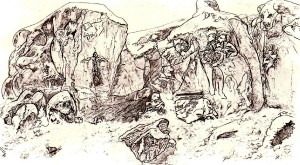
Perokreska skalních rytin na blocích ve svahu nad ruinami Incawasi.
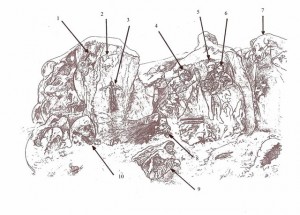
Kresby malíře Karla Janáka pořízeny dle fotografií Otto Horského, z roku 2004.

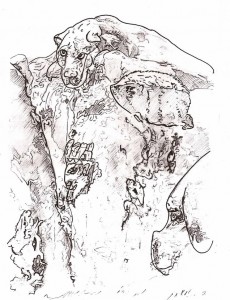
Puma byla Inky uctívána. Není proto zvláštností, že byla zobrazena na skalním bloku.
Kresby malíře Karla Janáka pořízeny dle fotografií Otto Horského z roku 2004.
The discovery of engravings on rock blocks in Incawasi, Peru, near Huaytara
Otto Horsky
The Empire of the Incas at the top of its government occupied 5,500 km of the greater part of the Andean ridge. Before the arrival of the Spanish conquerors in 1532, it was probably the largest known civilization, controlling the area from Quito in Ecuador to the Rio Maule River in Chile.
The Incas formed only a narrow layer of the ruling class, concentrating military power, both official and religious. Their supremacy strengthened the imperial religious myth of the primacy of this culture - they proclaimed that no civilization existed before them. As was the case with other advanced cultures. The new, dominant, almost always sought to liquidate everything that preceded it. Only the archaeological finds, especially in the last century, and the purposeful study of prehistoric ceramics in the territories of the former Inca kingdom of Tahuntinsuyu, or the "Land of Four Parts", highlighted the vast breadth and depth of many Andean civilizations that had preceded it. Unfortunately, the Spaniards have been treating the ruins and cemeteries for centuries as a mine land, and so far to some parts of the population, especially the Indian one. The by-product of the looting of archaeological sites and burial grounds was ceramics, which however was mostly located in art collections of European museums or private museums. The study of engravings and drawings created by previous civilizations in the Andean region on the rock blocks served as a giant canvas for the representation of animals and human beings, or mythical scenes. Perhaps because they could not be moved to museums or private collections because of their large size. Economically, this is and still is a very interesting object. Perhaps the second reason why little is known about them is human obsession and ignorance. Or the inability to see something that requires a degree of imagination and intuition.
The Incas during their reign and imperial politics created an empire comparable to the Roman or Ottoman Empire. In contrast, however, they always tried to negotiate peacefully with the tribes they intended to incorporate into the realm. The so-formed tribes behaved like allies, not as enemies. However, they have not always succeeded in preparing for a long-lasting bloody war. It was not easy in the high mountains they inhabited, concentrating on the fast-paced army and preparing it for the battles. That's why they built temporary military posts, forward military camps, serving to accommodate the Incas, generals and other military dignitaries, officials, servants, and soldiers to lead the war. These were called either Incahuasi, or Incawasi, meaning "Inky House". Since these imperial wars were led mainly after the inauguration of Inka Pachacuti on the throne (1438-1471) and later in the reign of his successor Tupaca Yupanki (1471-1493), these military camps were supposed to be built at the time of their reign.
Incahuasi usually has three sectors: Indian, Religious, and Inca Palace. The Inca quarter had houses with apartments, courtyards, and streets. The Palace of Inca had a trapezoidal shape and was placed at the highest point. Between the Inca palace and the Inca Quarter, a spiritual quarter and warehouses of food, equipment, and other necessary items were placed.
As part of the Czech research expedition Titicaca 2004, we visited a wide range of ruins of Inca and Pre-Roman settlements for comparative studies not only in Lake Titicaca but also in other areas of Peru. Among the sites visited were the Incawasi ruins.
After visiting the city of Pisco, which is famous for its favorite grape distillate with the same name, we set out along the "Los Libartadores" road leading to Ayacucha, and after about 112 km we arrived in a beautiful city called Huayatara. This city is not only a beautiful and unforgettable natural scenery, but also very important Inca ruins that can be compared to those in Cuzco or Machu Picchu. More than 1200 archeologically significant findings have been documented in 98 different localities.
A city with 25,000 inhabitants is located in the West Cordillera Mountains at an altitude of 2,500 meters. Despite this significant altitude, it is characterized by very favorable climatic conditions. Travel guides indicate that it is a city of eternal spring. The average annual temperature is 17 Co. Thanks to this favorable climate, intensive agriculture and livestock farming have developed. In addition to natural beauty, Huaytara and its surroundings offer architectural gems and ruins, which are worth seeing, even though they are somewhat part of the usual hiking trails. Among the most important Inca monuments are undoubtedly the "El Templo Inca" - the Palace of Inca, "Los Baños del Inca" - Hot and Cold Water Incineries, both in Huaytaire, as well as the terraces on the slopes of "Sumaq-Pata," and especially the ruins of a military camp Incahuasi.
From Huaytary we continued along the Los Libertadores road towards Ayacucho. After about 20 km, behind a small artificial lagoon, we went to the left after an uninterrupted field trip, and after about two kilometers of driving, we had to park the car to the last outpost, still accessible to the off-road vehicle. Below us, huge stone blocks spread across the hillside, and beneath them in the shallow valley of Inca ruins, Incawasi.
From the top of the ruins below us, the man is breathtaking. Place created for the Gods. Next we have to go on foot. At the 3900m outpost, serving as a lookout for the ruins, we arrived by car and without prior acclimatization. And so the way down to the ruins along the hiking trail up to the "only" 3775 m is not a walk through the paradise garden. We find majestic silhouettes of Inca architecture, dilapidated walls made of perfectly machined blocks of stone embedded with no mortar with admirable precision, with windows, doors, facades and stairs that do not fit in with similar buildings in Cuzco or Machu Picchu. Street and square with Intihuatana (sundial), a big block carved a small and large seat for Ink and some with its concubine, a food store for the civilian population and the army, an area with residences and ceremonies for God the Sun and Mother Earth. And ubiquitous water, squeezing artificially carved channels. According to archaeologists, the teeth of time and human indifference have made it possible to preserve only about 20% of the original building today with the architectural gem. But you too are worth it.
On the way back upstairs, where our off-road vehicle was parked, I had to stop several times to rest. The lack of oxygen and the heat of the midday sunshine took place. As I got back to the outpost and looked with admiration back at the Incahuasi ruins, my gaze rested on the huge rock blocks just below us. These and many other blocks on the right created a natural gate and a wall before the descent into a former military camp. I was stunned. On the left block, I saw the bright, majestic figure of a god or a preacher. In his raised hands, he snatched a scepter and looked up at the sky. On the right block there was a distinct figure of a sitting warrior with a helmet on his head, to the right of him stood an angular and unarmed warrior as his bodyguard. He was threatened by a strange supernatural creature from the right. He slipped my gaze on the opposite slope to the right, as if moving around, the giant beetles of stone, thanks to the play of light and shadows in the sunlight.
The work program of the expedition was very demanding and did not focus on studying rock engravings. Everyone else has left long ago not to bother the car on a challenging journey back along the field road, including the passage of dry gravel. It was impossible to go down to the rock blocks with mythical scenes and document them in detail. However, the captured photos and video recordings clearly show patterns, and there is so much that it is a unique discovery. It was only after their further study at home that many other details could be recognized, which could not be noticed due to the short time. The bodyguard reminds the robot, because the figure is angular and unbearable, and the hand is in the form of mechanical pliers. On the right above his head is the bright figure of a small man with a large head in a seated position, a humanoid who was also described from other parts of Peru. He has very distinct eyes and ears. Similar beings were probably inhabited by tight and low livelihoods in the ruins of the "Great Fortress" on the flat top of Marcahuasi (Roman Warszewski, 2000). On the left block to the right of the preacher's figure is a sheep, below which is the floating figure of a butterfly man with arms folded in the shape of wings. On the third block, which was not in the field, was the subject of my interest, the head of the bomb, which was innocent, was carved. Engraved patterns are so perfect that they testify to the extraordinary talent of the creators. Are they mythological figures or are reflections of reality? Are they the creations of human beings, or are they merely a coincidence and are the work of nature? As a geologist I should try to explain the natural origin of the engravings. Large temperature differences between day and night, rock blocks whipped by winds and rain in a time of disaster are all factors that cause intense erosion of rock blocks. But that nature would proceed according to such a precise scenario that would be a perfect reflection of reality? That does not seem likely. Let's admit, therefore, that the human hands, ethereal enthusiasm and faith in the supernatural, accompanying the lives of their creators, have been incorporated into these rock blocks. And the age of these scenes? I do not expect them to be from before the Inca cultures, as these climatic conditions would not allow them to survive for millennia.
The Incas used to use rocks and rock blocks for artistic rendition in the shape of deities, human beings, or worshiped animals. We can see similar scenes in Marcahuasi, or near Arequipo in southern Peru. During my visit to the ruins of Kenka near Cuzca, I managed to document the monolith that is still in dispute, whether it depicts a sexual symbol, a seal, or a bomb. As my photographs and the picture of the painter Karel Janák shows, he is undoubtedly a bomb.
The rock blocks in Incahuasi on the slopes before entering the military camp were directly offered to be used as a giant canvas to represent deities and other beings and scenes. Finally, the great Inca army mostly camped at the site for several months, so there was plenty of time not only for the construction of the camp but also for the arts. Further detailed study of discovered rock engravings and views of blocks of stone from different sides can bring many more surprises.
Indians similar to engravings in rock blocks know from other places of Peru. They told me about it. He claims that these are beings who are entangled in stone. In the case of Incahuasi, it is strange that a Christian motif appears on the left block, the scenes on the right block resemble extraterrestrial beings. But I am far from admitting extraterrestrial origins to them, just as I do not believe they are just a play of nature. Discovered engravings, commonly rendered by Incas and elsewhere, created with utter perfection, eyes, ears, hands, are more than eloquent.
Before leaving our expedition, my friend, from the Peruvian Altiplana, pointed out that in Peru in the high mountains I meet the mystery in its most archaic form. With many phenomena or phenomena I will not immediately understand and which will seem almost incomprehensible to me. I remembered the memory of my first visit to the royal city of Inca Cuzco in 1975, when the mayor was passionate about the mysterious observations of the acrobatic lights of the night sky and the observations of unidentified flying objects. But the discovery of Incahuasi rock engravings surpassed all my expectations. Unfortunately, the site is so inaccessible and aside from the usual hiking trails that if anyone wants to visit it, it will probably have to be done in its own right. From the point of view of the study of Prehispanic history, the Incahuasi ruins must be considered as an important archaeological entity and its own engravings for the contribution to the knowledge of the life and feelings of the Incas
The discovery of engravings in rock blocks in Incawasi in Peru near Huaytara
Introductory words of Dr. Aleberto Salas Barahona, Ambassador of Peru in the Czech Republic
The discovery of engravings in rock blocks in Incahuasi in Peru is described in detail in the book "Incawasi - the seat of the Gods" (Incawasi - sidlo bohů). © 2010, Repronis. It is one of the results of the studies carried out during the Titicaca expedition. Its conception dates from a time before the expedition, because it had the dedication to prepare technically and scientifically said trip, previously carrying out comparative studies of different Inca ruins, especially in the area of Huaytara, Cusco, Machu Picchu, Ollantaytambo, Pisac, Sacsayhuaman, Puca Pucara, Kenko, Tambo Machay, among others. The validity of Otto Horsky's work hypothesis was demonstrated with the checks made in the field. The basic chapters of the book are referred to the remarkable Inca architecture and the materials used for the mentioned monumental constructions, such as the Kenko temple, warehouses, administrative and defensive enclosures, such as Sacsayhuaman, Incawasi and Tambo Colorado, among other ruins . The presentation is accompanied not only by the author's photographs, but also by the paintings of the Czech artist Karel Janak. Mr. Horsky emphasizes that the archaeological remains in the Incawasi, near the city of Huaytara, are similar to those of Machu Picchu, due to the use of perfectly carved stones. In this place, at the entrance of the ruins precisely, Otto Horsky discovered large stones of cyclopean size with rock paintings probably of religious significance. Although in Peru there are registered hundreds of sites with cave paintings, especially in the Altiplano and in the inter-Andean valleys, each discovery means a contribution to the best knowledge of the pre-Columbian cultures. The rocks and engraved stones that exist of that time have as main characteristic that they are in open spaces, integrated to the landscape accessible to any visitor. Therefore, with good judgment, the author of the book highlights the need to adopt appropriate measures to preserve them from damage that may cause uncontrolled tourism.
This book shows, with the full conviction, that it will increase in a very significant way the knowledge about the vestiges and the ruins of ancestral and important cultures that populated the present Peru. For its content, this book is added to other important studies of Czech researchers, explorers and scientists who, since the 17th century, made the expeditions and trips to Peru, disseminating the results of their trips through written testimonies.
Alberto Salas Barahona, Ambassador of Peru in the Czech Republic, February 25, 2010.
English translation using automatic translators
Objev rytin na skalních blocích v Incawasi v Peru poblíž Huaytary.docx

